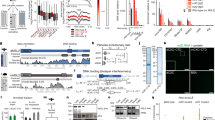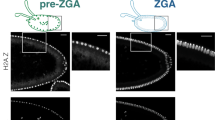Abstract
The male-specific lethal (MSL) complex upregulates the single male X chromosome to achieve dosage compensation in Drosophila melanogaster. We have proposed that MSL recognition of specific entry sites on the X is followed by local targeting of active genes marked by histone H3 trimethylation (H3K36me3). Here we analyze the role of the MSL3 chromodomain in the second targeting step. Using ChIP-chip analysis, we find that MSL3 chromodomain mutants retain binding to chromatin entry sites but show a clear disruption in the full pattern of MSL targeting in vivo, consistent with a loss of spreading. Furthermore, when compared to wild type, chromodomain mutants lack preferential affinity for nucleosomes containing H3K36me3 in vitro. Our results support a model in which activating complexes, similarly to their silencing counterparts, use the nucleosomal binding specificity of their respective chromodomains to spread from initiation sites to flanking chromatin.
This is a preview of subscription content, access via your institution
Access options
Subscribe to this journal
Receive 12 print issues and online access
$189.00 per year
only $15.75 per issue
Buy this article
- Purchase on Springer Link
- Instant access to full article PDF
Prices may be subject to local taxes which are calculated during checkout






Similar content being viewed by others
Accession codes
References
Koonin, E.V., Zhou, S. & Lucchesi, J.C. The chromo superfamily: new members, duplication of the chromo domain and possible role in delivering transcription regulators to chromatin. Nucleic Acids Res. 23, 4229–4233 (1995).
Marin, I. & Baker, B.S. Origin and evolution of the regulatory gene male-specific lethal-3. Mol. Biol. Evol. 17, 1240–1250 (2000).
Palmer, M.J., Richman, R., Richter, L. & Kuroda, M.I. Sex-specific regulation of the male-specific lethal-1 dosage compensation gene in Drosophila. Genes Dev. 8, 698–706 (1994).
Lyman, L.M., Copps, K., Rastelli, L., Kelley, R.L. & Kuroda, M.I. Drosophila Male-specific lethal-2 protein: structure/function analysis and dependence on MSL-1 for chromosome association. Genetics 147, 1743–1753 (1997).
Gu, W., Szauter, P. & Lucchesi, J.C. Targeting of MOF, a putative histone acetyl transferase, to the X chromosome of Drosophila melanogaster. Dev. Genet. 22, 56–64 (1998).
Demakova, O.V. et al. The MSL complex levels are critical for its correct targeting to the chromosomes in Drosophila melanogaster. Chromosoma 112, 103–115 (2003).
Alekseyenko, A.A., Larschan, E., Lai, W.R., Park, P.J. & Kuroda, M.I. High-resolution ChIP-chip analysis reveals that the Drosophila MSL complex selectively identifies active genes on the male X chromosome. Genes Dev. 20, 848–857 (2006).
Larschan, E. et al. MSL complex is attracted to genes marked by H3K36 trimethylation using a sequence-independent mechanism. Mol. Cell 28, 121–133 (2007).
Bell, O. et al. Transcription-coupled methylation of histone H3 at lysine 36 regulates dosage compensation by enhancing recruitment of the MSL complex in Drosophila. Mol. Cell. Biol. 28, 3401–3409 (2008).
Fagegaltier, D. & Baker, B.S. X chromosome sites autonomously recruit the dosage compensation complex in Drosophila males. PLoS Biol. 2, e341 (2004).
Oh, H., Bone, J.R. & Kuroda, M.I. Multiple classes of MSL binding sites target dosage compensation to the X chromosome of Drosophila. Curr. Biol. 14, 481–487 (2004).
Dahlsveen, I.K., Gilfillan, G.D., Shelest, V.I., Lamm, R. & Becker, P.B. Targeting determinants of dosage compensation in Drosophila. PLoS Genet. 2, e5 (2006).
Gilfillan, G.D. et al. Cumulative contributions of weak DNA determinants to targeting the Drosophila dosage compensation complex. Nucleic Acids Res. 35, 3561–3572 (2007).
Kind, J. & Akhtar, A. Cotranscriptional recruitment of the dosage compensation complex to X-linked target genes. Genes Dev. 21, 2030–2040 (2007).
Muller, H.J. & Altenburg, E. The frequency of translocations produced by X-Rays in Drosophila. Genetics 15, 283–311 (1930).
Schotta, G., Ebert, A., Dorn, R. & Reuter, G. Position-effect variegation and the genetic dissection of chromatin regulation in Drosophila. Semin. Cell Dev. Biol. 14, 67–75 (2003).
Grewal, S.I. & Jia, S. Heterochromatin revisited. Nat. Rev. Genet. 8, 35–46 (2007).
Zhang, K., Mosch, K., Fischle, W. & Grewal, S.I.S. Roles of the Clr4 methyltransferase complex in nucleation, spreading and maintenance of heterochromatin. Nat. Struct. Mol. Biol. 15, 381–388 (2008).
Elgin, S.C. & Grewal, S.I. Heterochromatin: silence is golden. Curr. Biol. 13, R895–R898 (2003).
Schwartz, Y.B. & Pirrotta, V. Polycomb silencing mechanisms and the management of genomic programmes. Nat. Rev. Genet. 8, 9–22 (2007).
Buscaino, A., Legube, G. & Akhtar, A. X-chromosome targeting and dosage compensation are mediated by distinct domains in MSL-3. EMBO Rep. 7, 531–538 (2006).
Zhang, P. et al. Structure of human MRG15 chromo domain and its binding to Lys36-methylated histone H3. Nucleic Acids Res. 34, 6621–6628 (2006).
Flanagan, J.F. et al. Molecular implications of evolutionary differences in CHD double chromodomains. J. Mol. Biol. 369, 334–342 (2007).
Groth, A.C., Fish, M., Nusse, R. & Calos, M.P. Construction of transgenic Drosophila by using the site-specific integrase from phage φC31. Genetics 166, 1775–1782 (2004).
Morales, V., Regnard, C., Izzo, A., Vetter, I. & Becker, P.B. The MRG domain mediates the functional integration of MSL3 into the dosage compensation complex. Mol. Cell. Biol. 25, 5947–5954 (2005).
Lucchesi, J.C., Kelly, W.G. & Panning, B. Chromatin remodeling in dosage compensation. Annu. Rev. Genet. 39, 615–651 (2005).
Alekseyenko, A.A. et al. A sequence motif within chromatin entry sites directs MSL establishment on the Drosophila X chromosome. Cell 134, 599–609 (2008).
Bailey, T.L. & Elkan, C. Fitting a mixture model by expectation maximization to discover motifs in biopolymers. Proc. Int. Conf. Intell. Syst. Mol. Biol. 2, 28–36 (1994).
Beermann, W. Chromomeres and genes. Results Probl. Cell Differ. 4, 1–33 (1972).
Carrozza, M.J. et al. Histone H3 methylation by Set2 directs deacetylation of coding regions by Rpd3S to suppress spurious intragenic transcription. Cell 123, 581–592 (2005).
Joshi, A.A. & Struhl, K. Eaf3 chromodomain interaction with methylated H3–K36 links histone deacetylation to Pol II elongation. Mol. Cell 20, 971–978 (2005).
Keogh, M.C. et al. Cotranscriptional Set2 methylation of histone H3 lysine 36 recruits a repressive Rpd3 complex. Cell 123, 593–605 (2005).
McDonel, P., Jans, J., Peterson, B.K. & Meyer, B.J. Clustered DNA motifs mark X chromosomes for repression by a dosage compensation complex. Nature 444, 614–618 (2006).
Ercan, S. et al. X chromosome repression by localization of the C. elegans dosage compensation machinery to sites of transcription initiation. Nat. Genet. 39, 403–408 (2007).
Yokoyama, R., Pannuti, A., Ling, H., Smith, E.R. & Lucchesi, J.C. A plasmid model system shows that Drosophila dosage compensation depends on the global acetylation of histone H4 at lysine 16 and is not affected by depletion of common transcription elongation chromatin marks. Mol. Cell. Biol. 27, 7865–7870 (2007).
Nagel, A.C., Maier, D. & Preiss, A. Green fluorescent protein as a convenient and versatile marker for studies on functional genomics in Drosophila. Dev. Genes Evol. 212, 93–98 (2002).
Kelley, R.L. et al. Epigenetic spreading of the Drosophila dosage compensation complex from roX RNA genes into flanking chromatin. Cell 98, 513–522 (1999).
Peng, S., Alekseyenko, A.A., Larschan, E., Kuroda, M.I. & Park, P.J. Normalization and experimental design for ChIP-chip data. BMC Bioinformatics 8, 219 (2007).
Li, B. et al. Combined action of PHD and chromo domains directs the Rpd3S HDAC to transcribed chromatin. Science 316, 1050–1054 (2007).
Li, B. et al. Preferential occupancy of histone variant H2AZ at inactive promoters influences local histone modifications and chromatin remodeling. Proc. Natl. Acad. Sci. USA 102, 18385–18390 (2005).
Li, B., Howe, L., Anderson, S., Yates, J.R. & Workman, J.L. The Set2 histone methyltransferase functions through the phosphorylated carboxyl-terminal domain of RNA polymerase II. J. Biol. Chem. 278, 8897–8903 (2003).
Acknowledgements
Special thanks to A.A. Alekseyenko (Harvard-Partners Center for Genetics and Genomics) for important advice, discussions and protocols, S. Khorasanizadeh for discussions and to members of the Kuroda laboratory for critical comments on the manuscript, H. Oh (currently at Rutgers University), for a key fly stock, and J. Racine and A. Sarovschii for technical assistance and the Taplin Biological Mass Spectrometry Facility (Harvard Medical School) for peptide identification. This work was supported by the US National Institutes of Health (NIH; GM45744 to M.I.K. and GM67825 to P.J.P.). B.L. and J.L.W. were supported by GM47867 from the NIH and by funding from the Stowers Institute for Medical Research.
Author information
Authors and Affiliations
Contributions
T.H.S. performed the mutagenesis, transgenic complementation, immunoprecipitations, ChIP-chip, purification of recombinant MSL3 and polytene-chromosome analyses; S.P. performed all bioinformatics analyses; B.L. performed the in vitro nucleosome binding assays; J.L.W., P.J.P. and M.I.K. supervised the analyses; T.H.S. and M.I.K. prepared the manuscript in consultation with all coauthors.
Corresponding author
Supplementary information
Supplementary Text and Figures
Supplementary Figures 1 and 2 and Supplementary Methods (PDF 751 kb)
Rights and permissions
About this article
Cite this article
Sural, T., Peng, S., Li, B. et al. The MSL3 chromodomain directs a key targeting step for dosage compensation of the Drosophila melanogaster X chromosome. Nat Struct Mol Biol 15, 1318–1325 (2008). https://doi.org/10.1038/nsmb.1520
Received:
Accepted:
Published:
Issue Date:
DOI: https://doi.org/10.1038/nsmb.1520
This article is cited by
-
Enhanced nucleotide chemistry and toehold nanotechnology reveals lncRNA spreading on chromatin
Nature Structural & Molecular Biology (2020)
-
Proximity ligation assays of protein and RNA interactions in the male-specific lethal complex on Drosophila melanogaster polytene chromosomes
Chromosoma (2015)
-
A new player in X identification: the CLAMP protein is a key factor in Drosophila dosage compensation
Chromosome Research (2014)



